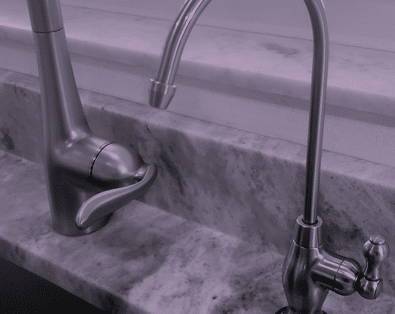Kitchen Sink: Why the Extra Faucet?

As a home inspector, from time to time you may come across a kitchen sink that has a third faucet in addition to the regular hot and cold faucet. This is referred to as a point of use (POU) faucet and is frequently used to dispense water that has been treated or filtered to improve its quality.
If you look under the sink, the system is typically mounted on the wall of the cabinet. In some cases it supplies filtered water to the ice maker in the refrigerator as well as to the POU faucet. The following are some examples of systems, starting at the simple, inexpensive end of the spectrum and progressing to more involved, costly options.
Option One
The entry level for a POU drinking water treatment system is a simple carbon cartridge filter to improve the taste and odor of the water, which is readily available from most water treatment professionals, plumbers, hardware stores, or online. In general, people will replace the cartridge themselves as needed based on the taste or odor returning.
In most cases the cartridge is manufactured to a standard size (approximately 2.5 inches by 10 inches) and is interchangeable with cartridges made by many manufacturers. The filter cartridge can consist of granular activated carbon (GAC) or some form of carbon block, which is more costly but may provide better performance and longer life. Carbon is used to improve water’s taste and odor and as part of many more sophisticated drinking water systems.
Option Two
One step up is a POU system designed and certified to remove a specific contaminant. It may incorporate a gallon counter, which can either turn the water off or alert you when a predetermined number of gallons has passed through the filter. Organizations like NSF or WQA offer performance certifications for contaminants like lead, arsenic, chlorine, and others. The cartridges for this type of system may need to be purchased from and changed by a water treatment professional.
Option Three
Perhaps the most comprehensive approach to high-quality drinking water is a POU reverse osmosis system (RO). The heart of the RO is a semipermeable membrane that rejects 90 to 98% of the dissolved minerals in the water. In addition to the membrane, these systems incorporate sediment and carbon cartridges.
One of the unique aspects of an RO system is that only about 25 to 35% of the water entering the system diffuses through the membrane and ends up being consumed. The rest of the water, along with the dissolved minerals rejected by the membrane, gets flushed down the drain. Because of the slow flow rate at which the water diffuses through the membrane (usually measured in milliliters per minute, not gallons per minute), most RO systems have a small pressure tank to ensure an adequate water supply is readily available when needed.
RO systems are rated by how many gallons per day they can produce. Keep in mind that the rating is normally based on an incoming water pressure of 60 psi and water temperature of 77 degrees Fahrenheit. If the temperature or pressure is lower, the system will produce fewer gallons per day.
It is typically easy to identify an RO system because almost all have a drain connection and pressure tank. RO systems are normally maintained annually by a trained professional because they require a level of servicing (including checking the pre-charge and sanitizing the storage tank) that is beyond what most homeowners are capable of completing. Many RO systems are also certified to remove certain contaminants from the water.
In Conclusion
You may encounter many systems in the course of performing an inspection. If the system was installed to address a health-related issue with the water, it is advisable to have the water tested before and after passing through the system to verify performance. Please remember that systems need to be used and maintained regularly. Stagnant water is never a desirable condition; it has the potential to allow bacteria to gain a foothold and cause aesthetic and possibly health-related problems. Hopefully you’ll find a sticker on the system indicating who installed it. If so, your client may be able to learn what the system is, when and why it was installed, and when it was last serviced.
If you have any water quality questions, please feel free to contact me at 978-302-1076 or paul@getwateranswers.com. As a home inspector, there is no charge to speak with me at length. I do not sell any water treatment equipment, only expertise, like yourselves.
Get Water Answers is a proud ASHI Affiliate member.
To Read the Full Article
ASHI offers its members unparalleled resources to advance their careers. ASHI offers training for inspectors at all levels of knowledge and experience, including resources about all major home systems. Members benefit from a vast network of experienced professionals, providing a community for mentorship and knowledge sharing..
In this Issue
Radon Monitors: Selecting the Right Device to Safeguard Your Clients
Bath Fan Venting Issues
The Challenges of Stone Veneer
Using Your Senses for Better Home Inspections
New Home Inspections
Electrical Codes: Be On the Lookout
Postcards from the Field

FIND A HOME
INSPECTOR
Professional Networking
Grow your professional network, find a mentor, network with the best, and best part of the community that’s making home inspection better every day.
